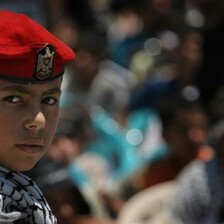The Electronic Intifada 4 April 2001
Much of the media portrays the current conflict between the Palestinians and the Israeli occupying army as an encounter or contest between equals, ignoring the massive imbalance of military, economic, political and diplomatic power between the Palestinian and Israeli sides.
Imbalances resulting from language use
Regularly, the media talks about “fighting between Israeli forces and Palestinian gunmen” to describe Israel’s use of tank and attack helicopter shells versus Palestinian rifles, or “clashes between Israeli forces and Palestinians” to describe Israel’s use of heavy machine guns and live ammunition against Palestinian stones and the occasional molotov cocktail.
Such careless language usage can create the illusion of an equally-matched battle. In an article entitled, “Violence Escalates In Mideast,” by Lee Hockstader for The Washington Post, on 3 April 2001, Hockstader wrote:
“Around the biblical town of Bethlehem, Israeli troops and Palestinian gunmen battled with tanks, machine guns, missiles and grenades today.”
But while some Palestinians have guns, only the Israelis have tanks, heavy-calibre machine guns, missiles and grenades. The report misleadingly suggested a battle between equal forces.
Ignoring the implicit imbalance of a military occupation
Media misinformation about the imbalance of power between the two sides is usually based on journalists’ and editors’ ignorance of the pervasiveness and detrimental nature of the Israeli military occupation, and — in many cases — ignorance of its continuation at all. Such ignorance is most often manifested in stilted attempts to “balance” reporting by presenting equal scenes of suffering from both sides as if the conflict were a war, even if the reality is strikingly one-sided.
Attempts at “balance” are regularly observed in the coverage of funerals, particularly by the television news media. It is not unusual to see coverage of a Palestinian funeral immediately followed by coverage of an Israeli funeral. Although both are real events that tear apart the lives of grieving families, the reality is often that several other Palestinians were shot dead and tens injured on the same day that a single Israeli was killed.
The media’s “one from each side” approach obscures the fact that Israel’s disproportionate use of weapons results in very disparate death and injury counts on either side. The attempt to balance the presentation of suffering in a report, though often well-intentioned, can give the illusion that both sides experience similar mortality rates and thus a comparable level of suffering.
Inferred balance from unchallenged soundbites; imbalance resulting from footage disparities
A classic example of media depictions of a ‘conflict between equals’ was seen in the reporting of Israel’s brutal and lethal April 1996 attack on Lebanon, code-named “Operation Grapes of Wrath.”
President Clinton and US Secretary of State Warren Christopher consistently and repeatedly called on “both sides to end the violence,” while in actual fact, the violence and its results were decidedly one-sided: Nearly 200 Lebanese civilians were killed by IAF and IDF attacks. 106 of them, more than half of whom were children, were killed in a single Israeli act of shelling that targeted a UN base in Qana, South Lebanon. No Israeli civilians were killed by incoming Hizbullah katyusha rockets during the 16-day conflict.
Western media outlets, however, with few exceptions, simply echoed the US and Israeli governments’ depictions of this military event, and the media showed more footage of Israeli civilians hiding in bomb shelters than images of terrified Lebanese civilians, who were suffering the physical, psychological, and economic effects of an unrelenting Israeli air, sea, and land bombardment (See the Middle East Research and Information Project (MERIP)’s Press Information Notes, Nos. 11 and 16, for more details).
Blindness to inappropriateness of Israel’s use of heavy weapons against civilian demonstrators
Journalist Robert Fisk, writing in the Independent on 6 October, commented:
Meanwhile our impartial media continues to suggest that there’s nothing very odd about using tanks and missiles against rioters and gunmen. The Los Angeles Times is now talking of the Israeli tactics as “heavy handed” —like a schoolmaster who prefers six of the best to three of the best — while BBC Television news told us when the first helicopter fired a missile into a Palestinian apartment block that the Israelis were “resorting to extreme measures”.
Had these acts been undertaken by any other state, the media would likely have “taken off the gloves” and called these acts by their proper names: War crimes and crimes against humanity (See the text of the Fourth Geneva Convention relative to the Protection of Civilian Persons in Time of War of 12 August 1949”).




